|
|
|
MOURGUE Pierre
Eveil. Robe d'après-midi, garnie de ruban (pl.2, La Gazette du Bon ton, 1921 n°1)
- Lucien Vogel éditeur, Paris 1921, 18x24cm, une feuille. - Original color print, printed on vergé paper, signed in the plate. An original print used to illustrate the Gazette du bon ton, one of the most attractive and influential 20th century fashion magazines, featuring the talents of French artists and other contributors from the burgeoning Art Deco movement. A celebrated fashion magazine established in 1912 by Lucien Vogel, La Gazette du bon ton appeared until 1925, with a hiatus from 1915 to 1920 due to the war (the editor-in-chief having been called up for service). It consisted of 69 issues printed in only 2,000 copies each and notably illustrated with 573 color plates and 148 sketches of the models of the great designers. Right from the start, this sumptuous publication "was aimed at bibliophiles and fashionable society," (Françoise Tétart-Vittu, "La Gazette du bon ton", in Dictionnaire de la mode, 2016) and was printed on fine vergé paper using a type cut specially for the magazine by Georges Peignot, known as Cochin, later used (in 1946) by Christian Dior. The prints were made using stencils, heightened in colors, some highlighted in gold or palladium. The story began in 1912, when Lucien Vogel, a man of the world involved in fashion (he had already been part of the fashion magazine Femina) decided, with his wife Cosette de Brunhoff - the sister of Jean, creator of Babar - to set up the Gazette du bon ton, subtitled at the time: "Art, fashion, frivolities." Georges Charensol noted the reasoning of the editor-in-chief: "'In 1910,' he observed, 'there was no really artistic fashion magazine, nothing representative of the spirit of the time. My dream was therefore to make a luxury magazine with truly modern artists...I was assured of success, because when it comes to fashion, no country on earth can compete with France.'" ("Un grand éditeur d'art. Lucien Vogel" in Les Nouvelles littéraires, no. 133, May 1925). The magazine was immediately successful, not only in France but also in the United States and Latin America. At first, Vogel put together a team of seven artists: André-Édouard Marty and Pierre Brissaud, followed by Georges Lepape and Dammicourt, as well as eventually his friends from school and the School of Fine Arts, like George Barbier, Bernard Boutet de Monvel and Charles Martin. Other talented people soon came flocking to join the team: Guy Arnoux, Léon Bakst, Benito, Boutet de Monvel, Umberto Brunelleschi, Chas Laborde, Jean-Gabriel Domergue, Raoul Dufy, Édouard Halouze, Alexandre Iacovleff, Jean Émile Laboureur, Charles Loupot, Chalres Martin, Maggie Salcedo. These artist, mostly unknown when Lucien Vogel sought them out, later became emblematic and sought-after artistic figures. It was also they who worked on the advertising drawings for the Gazette. The plates put the spotlight on, and celebrate, dresses by seven designers of the age: Lanvin, Doeuillet, Paquin, Poiret, Worth, Vionnet and Doucet. The designers provided exclusive models for each issue. Nonetheless, some of the illustrations are not based on real models, but simply on the illustrator's conception of the fashion of the day. The Gazette du bon ton was an important step in the history of fashion. Combining aesthetic demands with the physical whole, it brought together - for the first time - the great talents of the artistic, literary, and fashion worlds; and imposed, through this alchemy, a completely new image of women: slender, independent and daring, which was shared by the new generation of designers, including Coco Chanel, Jean Patou, Marcel Rochas, and so on... Taken over in 1920 by Condé Montrose Nast, the Gazette du bon ton was an important influence on the new layout and aesthetics of that "little dying paper" that Nast had bought a few years earlier: Vogue. [FRENCH VERSION FOLLOWS] Estampe originale en couleur, tirée sur papier vergé, signée en bas à droite de la planche. Gravure originale réalisée pour l'illustrat

|
|
|
MOURGUE Pierre
La Promenade au Palais-Royal. Redingote "Directoire" (pl.18, La Gazette du Bon ton, 1921 n°3)
- Lucien Vogel éditeur, Paris 1921, 18x24cm, une feuille. - Original color print heightened with palladium, printed on vergé paper, signed in the plate. An original print used to illustrate the Gazette du bon ton, one of the most attractive and influential 20th century fashion magazines, featuring the talents of French artists and other contributors from the burgeoning Art Deco movement. A celebrated fashion magazine established in 1912 by Lucien Vogel, La Gazette du bon ton appeared until 1925, with a hiatus from 1915 to 1920 due to the war (the editor-in-chief having been called up for service). It consisted of 69 issues printed in only 2,000 copies each and notably illustrated with 573 color plates and 148 sketches of the models of the great designers. Right from the start, this sumptuous publication "was aimed at bibliophiles and fashionable society," (Françoise Tétart-Vittu, "La Gazette du bon ton", in Dictionnaire de la mode, 2016) and was printed on fine vergé paper using a type cut specially for the magazine by Georges Peignot, known as Cochin, later used (in 1946) by Christian Dior. The prints were made using stencils, heightened in colors, some highlighted in gold or palladium. The story began in 1912, when Lucien Vogel, a man of the world involved in fashion (he had already been part of the fashion magazine Femina) decided, with his wife Cosette de Brunhoff - the sister of Jean, creator of Babar - to set up the Gazette du bon ton, subtitled at the time: "Art, fashion, frivolities." Georges Charensol noted the reasoning of the editor-in-chief: "'In 1910,' he observed, 'there was no really artistic fashion magazine, nothing representative of the spirit of the time. My dream was therefore to make a luxury magazine with truly modern artists...I was assured of success, because when it comes to fashion, no country on earth can compete with France.'" ("Un grand éditeur d'art. Lucien Vogel" in Les Nouvelles littéraires, no. 133, May 1925). The magazine was immediately successful, not only in France but also in the United States and Latin America. At first, Vogel put together a team of seven artists: André-Édouard Marty and Pierre Brissaud, followed by Georges Lepape and Dammicourt, as well as eventually his friends from school and the School of Fine Arts, like George Barbier, Bernard Boutet de Monvel and Charles Martin. Other talented people soon came flocking to join the team: Guy Arnoux, Léon Bakst, Benito, Boutet de Monvel, Umberto Brunelleschi, Chas Laborde, Jean-Gabriel Domergue, Raoul Dufy, Édouard Halouze, Alexandre Iacovleff, Jean Émile Laboureur, Charles Loupot, Chalres Martin, Maggie Salcedo. These artist, mostly unknown when Lucien Vogel sought them out, later became emblematic and sought-after artistic figures. It was also they who worked on the advertising drawings for the Gazette. The plates put the spotlight on, and celebrate, dresses by seven designers of the age: Lanvin, Doeuillet, Paquin, Poiret, Worth, Vionnet and Doucet. The designers provided exclusive models for each issue. Nonetheless, some of the illustrations are not based on real models, but simply on the illustrator's conception of the fashion of the day. The Gazette du bon ton was an important step in the history of fashion. Combining aesthetic demands with the physical whole, it brought together - for the first time - the great talents of the artistic, literary, and fashion worlds; and imposed, through this alchemy, a completely new image of women: slender, independent and daring, which was shared by the new generation of designers, including Coco Chanel, Jean Patou, Marcel Rochas, and so on... Taken over in 1920 by Condé Montrose Nast, the Gazette du bon ton was an important influence on the new layout and aesthetics of that "little dying paper" that Nast had bought a few years earlier: Vogue. [FRENCH VERSION FOLLOWS] Estampe originale en couleur rehaussée au palladium, tirée sur papier vergé, signée en bas à droite de la pla

|
|
|
MOURGUE Pierre
La Promenade au Palais-Royal. Redingote "Directoire" (pl.18, La Gazette du Bon ton, 1921 n°3)
- Lucien Vogel éditeur, Paris 1921, 18x24cm, une feuille. - Estampe originale en couleur rehaussée au palladium, tirée sur papier vergé, signée en bas à droite de la planche. Gravure originale réalisée pour l'illustration de La Gazette du bon ton, l'une des plus belles et des plus influentes revues de mode du XXème siècle, célébrant le talent des créateurs et des artistes français en plein essor de l'art déco. Célèbre revue de mode fondée en 1912 par Lucien Vogel, La Gazette du bon ton a paru jusqu'en 1925 avec une interruption durant la Guerre de 1915 à 1920, pour cause de mobilisation de son rédacteur en chef. Elle se constitue de 69 livraisons tirées à seulement 2000 exemplaires et est illustrée notamment de 573 planches en couleurs et de 148 croquis représentant des modèles de grands couturiers. Dès leur parution, ces luxueuses publications « s'adressent aux bibliophiles et aux mondains esthètes » (Françoise Tétart-Vittu « La Gazette du bon ton » in Dictionnaire de la mode, 2016). Imprimées sur beau papier vergé, elles utilisent une police typographique spécialement créée pour la revue par Georges Peignot, le caractère Cochin, repris en 1946 par Christian Dior. Les estampes sont réalisées grâce à la technique du pochoir métallique, rehaussées en couleurs et pour certaines soulignées à l'or ou au palladium. L'aventure commence en 1912 lorsque Lucien Vogel, homme du monde et de la mode - il a déjà participé à la revue Femina - décide de fonder avec sa femme Cosette de Brunhoff (sur de Jean, le père de Babar) la Gazette du bon ton dont le sous-titre est alors « Art, modes et frivolités ». Georges Charensol rapporte les propos du rédacteur en chef : « En 1910, observe-t-il, il n'existait aucun journal de mode véritablement artistique et représentatif de l'esprit de son époque. Je songeais donc à faire un magazine de luxe avec des artistes véritablement modernes [...] J'étais certain du succès car pour la mode aucun pays ne peut rivaliser avec la France. » (« Un grand éditeur d'art. Lucien Vogel » in Les Nouvelles littéraires, n°133, mai 1925). Le succès de la revue est immédiat, non seulement en France, mais aussi aux Etats-Unis et en Amérique du Sud. À l'origine, Vogel réunit donc un groupe de sept artistes : André-Édouard Marty et Pierre Brissaud, suivis de Georges Lepape et Dammicourt ; et enfin ses amis de l'École des beaux-arts que sont George Barbier, Bernard Boutet de Monvel, ou Charles Martin. D'autres talents viennent rapidement rejoindre l'équipée : Guy Arnoux, Léon Bakst, Benito, Boutet de Monvel, Umberto Brunelleschi, Chas Laborde, Jean-Gabriel Domergue, Raoul Dufy, Édouard Halouze, Alexandre Iacovleff, Jean Émile Laboureur, Charles Loupot, Charles Martin, Maggie Salcedo. Ces artistes, inconnus pour la plupart lorsque Lucien Vogel fait appel à eux, deviendront par la suite des figures artistiques emblématiques et recherchées. Ce sont ces mêmes illustrateurs qui réalisent les dessins des publicités de la Gazette. Les planches mettent en lumière et subliment les robes de sept créateurs de l'époque : Lanvin, Doeuillet, Paquin, Poiret, Worth, Vionnet et Doucet. Les couturiers fournissent pour chaque numéro des modèles exclusifs. Néanmoins, certaines des illustrations ne figurent aucun modèle réel, mais seulement l'idée que l'illustrateur se fait de la mode du jour. La Gazette du bon ton est une étape décisive dans l'histoire de la mode. Alliant l'exigence esthétique et l'unité plastique, elle réunit pour la première fois les grands talents du monde des arts, des lettres et de la mode et impose, par cette alchimie, une toute nouvelle image de la femme, élancée, indépendante et audacieuse, également portée par la nouvelle génération de couturiers Coco Chanel, Jean Patou, Marcel Rochas... Reprise en 1920 par Condé Montrose Nast, la Gazette du bon ton inspirera largement la nouvelle composition et les choix esthétiques du « petit journal mourant » que Nast avait racheté quelques années auparavant : le magazine Vogue.

|
|
|
MOURGUE Pierre
La Visite à l'Ermitage. Cape en ruban (pl.49, La Gazette du Bon ton, 1921 n°7)
- Lucien Vogel éditeur, Paris 1921, 18x24cm, une feuille. - Original color print, printed on vergé paper, signed in the plate. An original print used to illustrate the Gazette du bon ton, one of the most attractive and influential 20th century fashion magazines, featuring the talents of French artists and other contributors from the burgeoning Art Deco movement. A celebrated fashion magazine established in 1912 by Lucien Vogel, La Gazette du bon ton appeared until 1925, with a hiatus from 1915 to 1920 due to the war (the editor-in-chief having been called up for service). It consisted of 69 issues printed in only 2,000 copies each and notably illustrated with 573 color plates and 148 sketches of the models of the great designers. Right from the start, this sumptuous publication "was aimed at bibliophiles and fashionable society," (Françoise Tétart-Vittu, "La Gazette du bon ton", in Dictionnaire de la mode, 2016) and was printed on fine vergé paper using a type cut specially for the magazine by Georges Peignot, known as Cochin, later used (in 1946) by Christian Dior. The prints were made using stencils, heightened in colors, some highlighted in gold or palladium. The story began in 1912, when Lucien Vogel, a man of the world involved in fashion (he had already been part of the fashion magazine Femina) decided, with his wife Cosette de Brunhoff - the sister of Jean, creator of Babar - to set up the Gazette du bon ton, subtitled at the time: "Art, fashion, frivolities." Georges Charensol noted the reasoning of the editor-in-chief: "'In 1910,' he observed, 'there was no really artistic fashion magazine, nothing representative of the spirit of the time. My dream was therefore to make a luxury magazine with truly modern artists...I was assured of success, because when it comes to fashion, no country on earth can compete with France.'" ("Un grand éditeur d'art. Lucien Vogel" in Les Nouvelles littéraires, no. 133, May 1925). The magazine was immediately successful, not only in France but also in the United States and Latin America. At first, Vogel put together a team of seven artists: André-Édouard Marty and Pierre Brissaud, followed by Georges Lepape and Dammicourt, as well as eventually his friends from school and the School of Fine Arts, like George Barbier, Bernard Boutet de Monvel and Charles Martin. Other talented people soon came flocking to join the team: Guy Arnoux, Léon Bakst, Benito, Boutet de Monvel, Umberto Brunelleschi, Chas Laborde, Jean-Gabriel Domergue, Raoul Dufy, Édouard Halouze, Alexandre Iacovleff, Jean Émile Laboureur, Charles Loupot, Chalres Martin, Maggie Salcedo. These artist, mostly unknown when Lucien Vogel sought them out, later became emblematic and sought-after artistic figures. It was also they who worked on the advertising drawings for the Gazette. The plates put the spotlight on, and celebrate, dresses by seven designers of the age: Lanvin, Doeuillet, Paquin, Poiret, Worth, Vionnet and Doucet. The designers provided exclusive models for each issue. Nonetheless, some of the illustrations are not based on real models, but simply on the illustrator's conception of the fashion of the day. The Gazette du bon ton was an important step in the history of fashion. Combining aesthetic demands with the physical whole, it brought together - for the first time - the great talents of the artistic, literary, and fashion worlds; and imposed, through this alchemy, a completely new image of women: slender, independent and daring, which was shared by the new generation of designers, including Coco Chanel, Jean Patou, Marcel Rochas, and so on... Taken over in 1920 by Condé Montrose Nast, the Gazette du bon ton was an important influence on the new layout and aesthetics of that "little dying paper" that Nast had bought a few years earlier: Vogue. [FRENCH VERSION FOLLOWS] Estampe originale en couleur, tirée sur papier vergé, signée en bas à droite de la planche. La Gazette du bon ton, l'une des plus belles et des pl

|
|
|
MOURGUE Pierre
La Visite à l'Ermitage. Cape en ruban (pl.49, La Gazette du Bon ton, 1921 n°7)
- Lucien Vogel éditeur, Paris 1921, 18x24cm, une feuille. - Estampe originale en couleur, tirée sur papier vergé, signée en bas à droite de la planche. La Gazette du bon ton, l'une des plus belles et des plus influentes revues de mode du XXème siècle, célébrant le talent des créateurs et des artistes français en plein essor de l'art déco. Célèbre revue de mode fondée en 1912 par Lucien Vogel, La Gazette du bon ton a paru jusqu'en 1925 avec une interruption durant la Guerre de 1915 à 1920, pour cause de mobilisation de son rédacteur en chef. Elle se constitue de 69 livraisons tirées à seulement 2000 exemplaires et est illustrée notamment de 573 planches en couleurs et de 148 croquis représentant des modèles de grands couturiers. Dès leur parution, ces luxueuses publications « s'adressent aux bibliophiles et aux mondains esthètes » (Françoise Tétart-Vittu « La Gazette du bon ton » in Dictionnaire de la mode, 2016). Imprimées sur beau papier vergé, elles utilisent une police typographique spécialement créée pour la revue par Georges Peignot, le caractère Cochin, repris en 1946 par Christian Dior. Les estampes sont réalisées grâce à la technique du pochoir métallique, rehaussées en couleurs et pour certaines soulignées à l'or ou au palladium. L'aventure commence en 1912 lorsque Lucien Vogel, homme du monde et de la mode - il a déjà participé à la revue Femina - décide de fonder avec sa femme Cosette de Brunhoff (sur de Jean, le père de Babar) la Gazette du bon ton dont le sous-titre est alors « Art, modes et frivolités ». Georges Charensol rapporte les propos du rédacteur en chef : « En 1910, observe-t-il, il n'existait aucun journal de mode véritablement artistique et représentatif de l'esprit de son époque. Je songeais donc à faire un magazine de luxe avec des artistes véritablement modernes [...] J'étais certain du succès car pour la mode aucun pays ne peut rivaliser avec la France. » (« Un grand éditeur d'art. Lucien Vogel » in Les Nouvelles littéraires, n°133, mai 1925). Le succès de la revue est immédiat, non seulement en France, mais aussi aux Etats-Unis et en Amérique du Sud. À l'origine, Vogel réunit donc un groupe de sept artistes : André-Édouard Marty et Pierre Brissaud, suivis de Georges Lepape et Dammicourt ; et enfin ses amis de l'École des beaux-arts que sont George Barbier, Bernard Boutet de Monvel, ou Charles Martin. D'autres talents viennent rapidement rejoindre l'équipée : Guy Arnoux, Léon Bakst, Benito, Boutet de Monvel, Umberto Brunelleschi, Chas Laborde, Jean-Gabriel Domergue, Raoul Dufy, Édouard Halouze, Alexandre Iacovleff, Jean Émile Laboureur, Charles Loupot, Charles Martin, Maggie Salcedo. Ces artistes, inconnus pour la plupart lorsque Lucien Vogel fait appel à eux, deviendront par la suite des figures artistiques emblématiques et recherchées. Ce sont ces mêmes illustrateurs qui réalisent les dessins des publicités de la Gazette. Les planches mettent en lumière et subliment les robes de sept créateurs de l'époque : Lanvin, Doeuillet, Paquin, Poiret, Worth, Vionnet et Doucet. Les couturiers fournissent pour chaque numéro des modèles exclusifs. Néanmoins, certaines des illustrations ne figurent aucun modèle réel, mais seulement l'idée que l'illustrateur se fait de la mode du jour. La Gazette du bon ton est une étape décisive dans l'histoire de la mode. Alliant l'exigence esthétique et l'unité plastique, elle réunit pour la première fois les grands talents du monde des arts, des lettres et de la mode et impose, par cette alchimie, une toute nouvelle image de la femme, élancée, indépendante et audacieuse, également portée par la nouvelle génération de couturiers Coco Chanel, Jean Patou, Marcel Rochas... Reprise en 1920 par Condé Montrose Nast, la Gazette du bon ton inspirera largement la nouvelle composition et les choix esthétiques du « petit journal mourant » que Nast avait racheté quelques années auparavant : le magazine Vogue. [ENGLISH DESCRIPTION ON DEMAND]

|
|
|
Moutafchieva, Irina, Staff
Hungarian Graphics from the Collection of the National Gallery for Foreign Art
12 loose leaf prints ( 12" wide x 16.5" high) on heavy paper in a paper cover illustrated with a print on the front and representations of the enclosed prints on the back from an exhibition at the gallery of the publisher. One sheet of text by Ms. Moutafchieva in three languages: Russian, Bulgarian and English. Prints are by the following artists: Istvan Szonyi, Gyula Hincz, Karoly Reich, Kalman Csohany, Csaba Rekassy, Gyula Feledy, Arnold Gross, Janos Kass, Margit Agotha, Imre Kovacs, Gabriella Molnar, Bela Tassy. Three are in color and the remainder in b&w, as produced. Publication date is not listed and estimated.

|
|
|
Mowat Farley Text by / Blackwood David Prints and Drawings by
Wake of the Great Sealers
Atlantic Monthly Press c. Collectible - Good. First edition copy. Collectible - Good. Good dust jacket. Bookplate inside. Atlantic Monthly Press c unknown
书商的参考编号 : J02C-00375
|
|
|
Mowat Farley Text by / Blackwood David Prints and Drawings by
Wake of the Great Sealers
Atlantic Monthly Press c 1973-01-01. Hardcover. Good. 11.7000 inches 10.5000 inches. Dust jacket wear all pages clean. Atlantic Monthly Press c hardcover
书商的参考编号 : mon0001388394
|
|
|
MOYREAU Jean
La marchande de marée
D’après P. Wouvermens. 36 x 29
书商的参考编号 : 5723
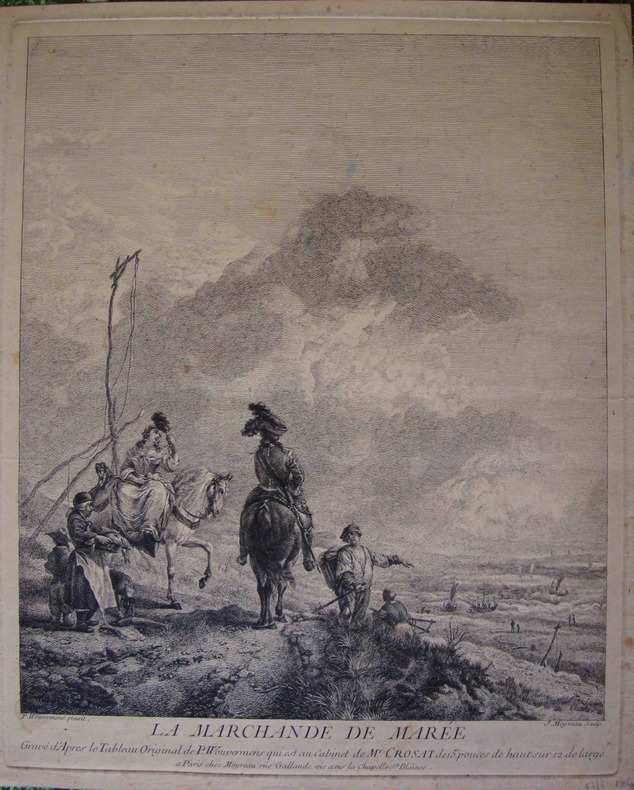
|
|
|
Mozart.-
Wolfgang Amadeus Mozart.
Zürich, Orell, Füssli und Comp. 1866. Gross-8°. 24 S. Mit 2 Portraits auf 1 lithogr. Tafel von H. Bodmer u. J. Lier. Orig.-Broschur (Deckel lose, stockfleckig). = "Neujahrsblatt der Allgemeinen Musikgesellschaft Zürich", Nr. 54.
书商的参考编号 : 27261AB
|
|
|
Mrs. John A. Logan et al; Engravings Illustrator
THE HOME MANUAL Everybody's Guide In Social Domestic And Business Life. A Treasury Of Useful Information For The Million. Profusely Illustrated. The Contents of One Hundred Books in a Single Volume. Touches Ten Thousand Topics.
H. J. Smith & Co 1889-01-01. Hardcover. Acceptable. Bound in red boards. Spine perished. Marbled end pages. 533 pages illustrations. Hardcover. Gutters cracked. Owner's name on end pages. Dampstained. Edges and corners chipped. Sold with all faults. This is an oversized or heavy book which requires additional postage for international delivery outside the US. H. J. Smith & Co hardcover
书商的参考编号 : 1908090021
|
|
|
MUCHA Alphonse Mucha Alphonse
GISMONDA, Sarah Bernhardt, Théâtre de la Renaissance. Les Maitres de l'Affiche Pl. 27
Pars Imprimerie Chaix 1897 Planche N°27, format 29 x 40 cm (toutes marges). Chromolithographie d'époque avec le timbre à sec de l'Imprimerie Chaix (Lugt 1777c). Notre exemplaire est une des très rares épreuves imprimées sur papier Japon (Our plate is one of the few copies printed on Japanese paper). Original plate in good condition). LES MAITRES DE L'AFFICHE, prestigieuse publication d'art, éditée par l'atelier de lithographie Chaix, dont la parution s'étala de décembre 1895 à novembre 1900. Chaque livraison comportait 4 planches de reproduction en chromolithographie d'une remarquable qualité d'impression des plus belles affiches illustrées des grands artistes français et étrangers (auxquelles il faut ajouter 16 planches de lithographies originales données en prime aux abonnés). Lors de l'Exposition universelle de 1889, fut organisée la première exposition rétrospective dévolue à l'affiche, celle-ci devait valider la reconnaissance officielle d'appartenance de l'affiche au monde de l'art. Jules Chéret (1836-1932) y sera sacré '' Maître de l'affiche '', c'est aussi à cette date que Seurat commencera à collectionner les affiches de Chéret. Alfons Maria Mucha, 1860-1939. Bel exemplaire d'une des très rares épreuves imprimées sur papier Japon, du tirage de tête (Our plate is one of the few copies printed on Japanese paper) ( Photographies sur demande / We can send pictures of this book on simple request )
书商的参考编号 : 24137
|
|
|
MUCHA (Alfons).
L'Estampe Moderne - N°4 - Août 1897.COUVERTURE ORIGINALE DE LIVRAISON SEULE (pas d'estampe à l'intérieur).
1898 P., Imprimerie Champenois, 1897, 1 couverture recto-verso in-folio (format replié : 410 x 310 mm), papier épais gris.Parfait état.
书商的参考编号 : 13742
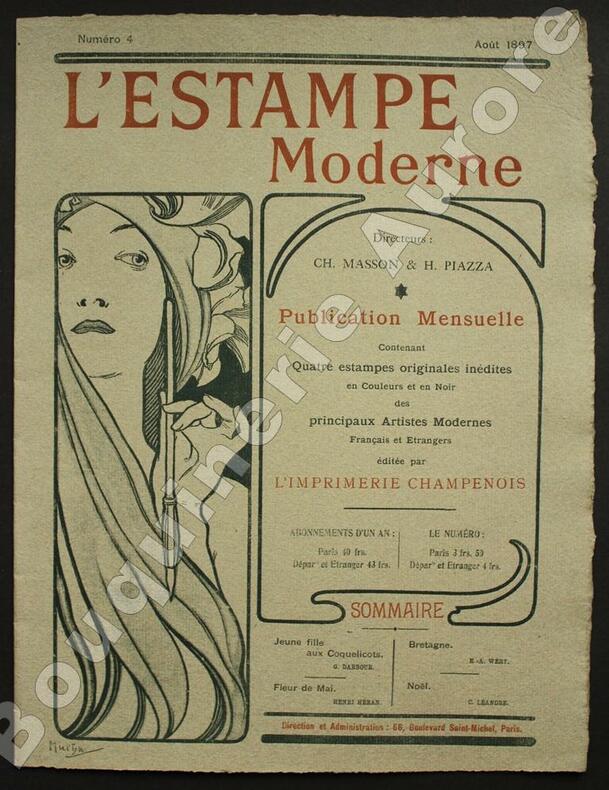
|
|
|
MUCHA Alphonse Mucha Alphonse
XXème EXPOSITION DU SALON DES CENT. Les Maitres de l'Affiche Pl. 94
Pars Imprimerie Chaix 1897 Planche N°94, format 29 x 40 cm (toutes marges). Chromolithographie d'époque avec le timbre à sec de l'Imprimerie Chaix (Lugt 1777c). Notre exemplaire est une des très rares épreuves imprimées sur papier Japon (Our plate is one of the few copies printed on Japanese paper, original plate in good condition). LES MAITRES DE L'AFFICHE, prestigieuse publication d'art, éditée par l'atelier de lithographie Chaix, dont la parution s'étala de décembre 1895 à novembre 1900. Chaque livraison comportait 4 planches en lithographie, des plus belles affiches illustrées des grands artistes français et étrangers. Chaque livraison comportait 4 planches de reproduction en chromolithographie d'une remarquable qualité d'impression des plus belles affiches illustrées des grands artistes français et étrangers (auxquelles il faut ajouter 16 planches de lithographies originales données en prime aux abonnés). Lors de l'Exposition universelle de 1889, fut organisée la première exposition rétrospective dévolue à l'affiche, celle-ci devait valider la reconnaissance officielle d'appartenance de l'affiche au monde de l'art. Jules Chéret (1836-1932) y sera sacré '' Maître de l'affiche '', c'est aussi à cette date que Seurat commencera à collectionner les affiches de Chéret. Bel exemplaire d'une des très rares épreuves imprimées sur papier Japon, du tirage de tête (Our plate is one of the few copies printed on Japanese paper) ( Photographies sur demande / We can send pictures of this book on simple request )
书商的参考编号 : 24136
|
|
|
Mudie Robert
The Feathered Tribes of the British Islands
London Eng: Whittaker & Co 1835. 2nd Edition. Hardcover. Good -. 2 volumes: xxiv 379 5 p.; 389 5 p.: hand-colored frontispiece and hand-colored title vignette in each volume 18 hand-colored plates several in-text drawings in each volume; 21 cm. Original dark green cloth with gilt-stamped spine titles and decoration; all boards have blind-stamped decoration. Yellow endpapers. In Good- Condition: front hinge of vol. 1 completely separated and front free endpaper and frontispiece of vol. 1 detached but present text block is otherwise solid and binding is in one piece; spines are sunned; cloth lacking at ends of spines; corners are bumped; covers are slightly soiled; title pages are foxed; otherwise only occasional light foxing; pages and plates are otherwise clean and tight. <br/><br/> Whittaker & Co hardcover
书商的参考编号 : 000819

|
|
|
Mueller Hans Alexander
How I Make Woodcuts & Engravings
New York NY: American Artists Group 1945. Main title: How I make woodcuts & wood engravings by Hans Alexander Mueller. Published/Created: New York American artists group inc. 1945. Description: 5 p. l. 3-96 p. 1 l. illus. part col. 24.5 cm. . Cloth. Very Good/No Jacket. 8vo. American Artists Group Hardcover
书商的参考编号 : ArtTech3011

|
|
|
Mueller Hans Alexander Wood Engravings by. Matthew Mark Luke John
THE FOUR GOSPELS OF MATTHEW MARK LUKE JOHN WITH WOOD ENGRAVINGS BY HANS ALEXANDER MUELLER AND LIMITED TO 985 COPIES OF WHICH THIS IS NUMBER 617
Peter Pauper Press. VG-/NONE. N.D. Limited Edition 617 of 985. Hardcover. Slip case is missing. Very good minus condition with only very minor usage showing. Spine is red/gold lettering. Almost all red color is gone. Front and rear covers are b/w with many illustrations of crosses. Cover corners ave a tiny bit of open wear. Also minor wear at bottom spine edge. Text is clean/tight. Pre-title pages gives limited edition information that this is number 617 of the 985 printed. Signed in pencil by illustrator. Wood cut engravings are quite exquisite. ; 8x12; 263 pages; Signed by Illustrator . Peter Pauper Press hardcover
书商的参考编号 : 24177
|
|
|
MUELLER HANS ANDERSON WITH WOOD ENGRAVINGS BY
The Four Gospels Of Matthew Mark Luke And John
The Peter Pauper Press Mount Vernon. Hardcover no dustjacket. Reading copy. Signed by the woodcut artist. Contains large readable print fo easy reading. Page size is 8"x12". Text is in black print with the names of the Gospel authors and page number in crimson. The Peter Pauper Press, Mount Vernon hardcover
书商的参考编号 : 70502X1
|
|
|
MULINARI Stéphano
(Le lever de Vénus)
D’après un beau dessin de Parmigianino 23 x 34
书商的参考编号 : 5722
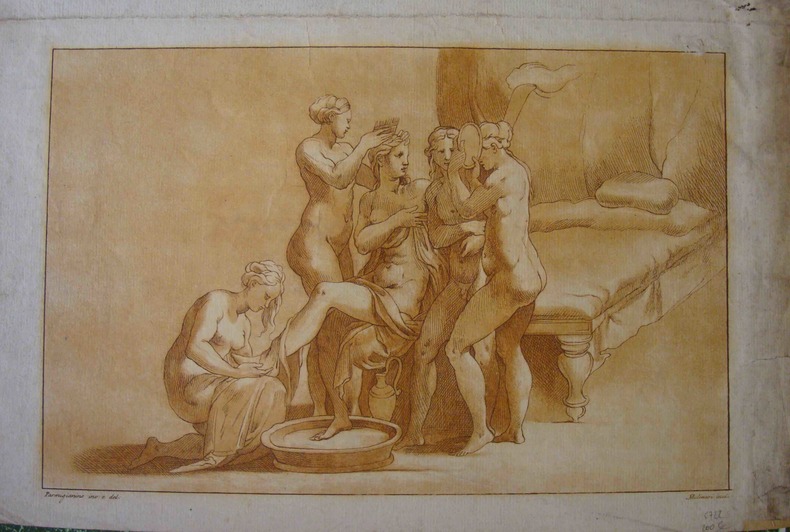
|
|
|
MULLER Jan Harmensz
Le combat d'Ulysse et d'Irus
Épreuve coupée à la cuvette. en feuille Bon Visscher Cornelis 1589 42,5 x 33 cm
书商的参考编号 : 14610
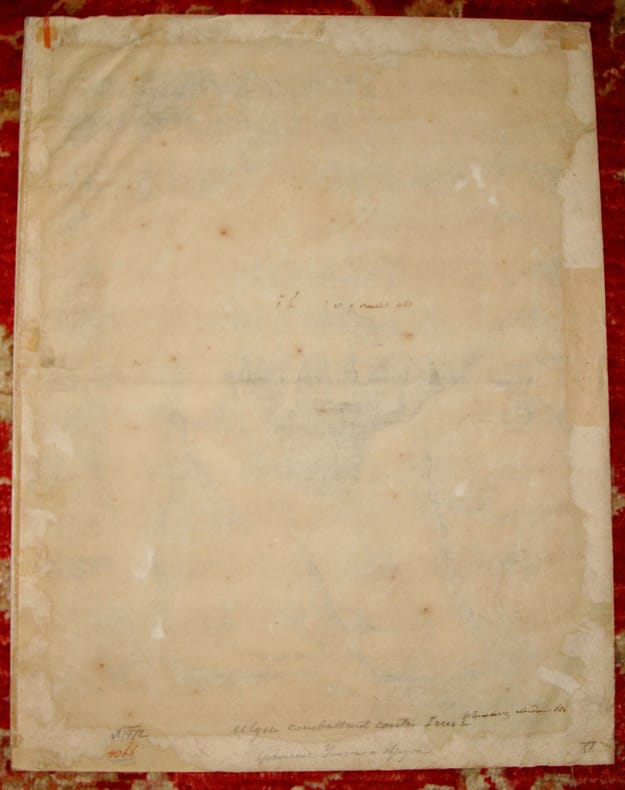
|
|
|
MULLER LINOW BRUNO ART PRINTS Muller Linow Bruno illus.
Radierungen.
Eltville am Rhein Germany.: Walter's Druckerei GmbH und Verlag. 1980. Hard cover volume 8 1/2 x 12 inches 85 pages with 62 illustrations of etchings by artist Bruno Müller-Linow. Small bump to bottom free edge of front cover extending to interior pages; area of light spotting to rear cover. Contents in very good clean condition. An attractive volume with high quality reproductions of etchings by Müller-Linow. Good condition with issues noted. Text in German. . Walter's Druckerei GmbH und Verlag. hardcover
书商的参考编号 : 52571

|
|
|
Muller, Josef Felix
Josef Felix Muller. Werkverzeichnis der Druckgraphik 1976-1992. Catalogue raisonne
The catalogue raisonne. Hundreds of items thoroughly described, all illustrated in color and black & white. 4to. Publisher's cloth. Dustjacket. FINE AND BRIGHT.
|
|
|
Multiple Contributors
Canadian Antiques Collector Magazine - November/December 1973
Features: Toile de Jouy - textile pattern; Symposium '73; Loyalist Settlement of Upper Canada; British Sporting Prints; Chine Export Trade Porcelain; Chinese Chippendale. Average wear. Address label upon front cover. Unmarked. Sound copy. Magazine

|
|
|
Multiple Contributors
Ikebana International, Issue No. 57
Features: Cover artist - Liao Shiou-ping; Saga School - Chiko School; Ikenobo School; Ichiyo School; Koryu Shohtoh-kai School; Floral Designs in Japanese Lacquer - many lovely colour photos with article; That day in Tehran when Ohara Houn Made an Old Man Cry; Ohara School; Soami School; Ryusei School; Japanese Contemporary Prints; Sogetsu School. Moderate wear. Unmarked. A sound copy. Book

|
|
|
Multiple Contributors
Shooting Times and Country Magazine: September 11-17, 1980
Features: Of Mink and Mallard; Modern Firearm Engravings; and more. Book

|
|
|
MUNSTER Sébastien
LEON (Lyon)
Très belle vue de la ville de Lyon, au XVIè siècle : la Saône, le Rhône, Saint-Jean, les ponts etc… Édition allemande qui transparait un peu au verso. En feuille Très bon 260 x 330 ; 440 x 515 avec le cadre.
书商的参考编号 : 5538
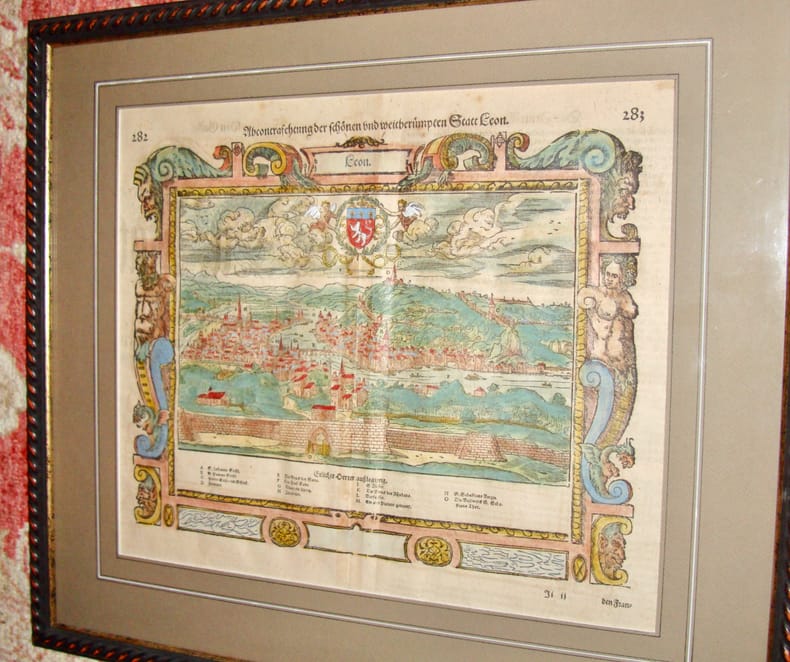
|
|
|
Munch, Edvard / Moshenson, Edna [Ed.]
Edvard Munch: Prints, The Charles & Evelyn Kramer Collection at the Tel Aviv Museum of Art [IN HEBREW AND ENGLISH]
IN HEBREW AND ENGLISH. 26X21 cm. 199+47 pages. Softcover. Cover slightly chafed. Library copy with usual signs. Else in good condition.
|
|
|
Munroe G. S. / Editor / with Engravings By O. Pelton and Illuminated Engraved Pages By Sharp
The Keepsake of Friendship : A Christmas and New Year's Annual for 1851 Anecdotes Poetry Prose Verse Personal Recollections Poetic Rhetoric and Rhyming Story / Stories Enjoyable Reading Antique Book
Clean and Unmarked Text: Worcester : Published By E. N. Tucker 1851 Disbound hardcover book. Front board is detached but present spine leather missing paper shows. Decorative gold embossed boards with edgewear. Back board still attached. All end papers still present and in place. Previous owner name in pencil on ffep middle. Illuminated presentation page by Sharp is not filled in illuminated title page is slightly chipped on outer edge it is also the point of detatchment of the front board. Gilt gold ends of pages. There are four / 4 exquisite engravings by O. Pelton who was a major engraver active during early 1800s. Pelton 1798 to 1882 was most well known for engravings depicting America's first president George Washington. These 4 magnificent engravings far outweigh the value of the book itself. They are all tissued but show paper age acid or oxicidation marks. All 4 are suitable for framing. These engravings by O. Pelton are true works of art themselves. Photos available upon request. Engravings include: The Look Out The Quiet Bay Well of St. Keyne and Happy Family. Book is a compilation of short story poetry prose pertaining to friends friendship and society in the mid 1800s or mid nineteenth century. 322 pages. Bookseller plate on final inside board small. . No Edition Stated. Leather. Illus. by Engravings and Illuminated Text. . Keepsake / Memento / Souvenir . Poetry Reading Pleasure. Worcester : Published By E. N. Tucker 1851 Hardcover
书商的参考编号 : 5021736
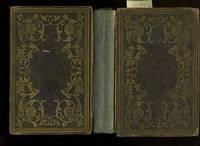
|
|
|
Munsing, Stepfan P.; Grote, Ludwig
Die Maler am Bauhaus
25.5X18.5 cm. Unnumbered pages. Softcover. Cover slightly chafed slightly detached at top and bottom edges. Spine slightly chafed. Binding visible on one page. Else in good condition.
|
|
|
Murer, Josef:
Der uralten wytbekannten Statt Zürich gestalt und gelägenheit, wie sy zu diser zyt in wäsen, ufgerissen und in grund gelegt, durch Josefen Murer und durch Christoffel Froschower, zu Eeren dem Vatterland getruckt, Im M.D.LXXVI Jar
Gattikon, Verlag Dorfpresse. 1966. Lithografie auf festem Papier. Blattgrösse: 97 x 139 cm.
书商的参考编号 : 1733AG
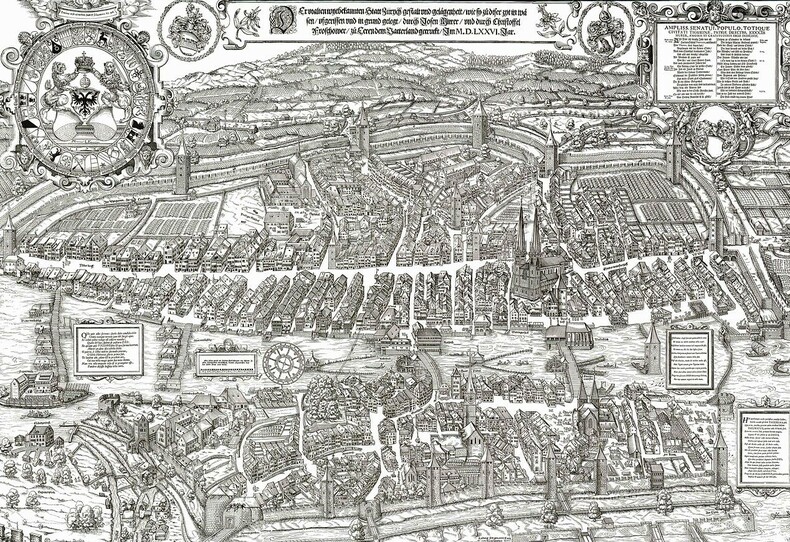
|
|
|
Murer, Josef:
Der uralten wytbekannten Statt Zürich gestalt und gelägenheit, wie sy zu diser zyt in wäsen, ufgerissen und in grund gelegt, durch Josefen Murer und durch Christoffel Froschower, zu Eeren dem Vatterland getruckt, Im M.D.LXXVI Jar
Gattikon, Verlag Dorfpresse. 1966. Zehnfarben Lithografie auf festem Papier. Blattgrösse: 97 x 139 cm.
书商的参考编号 : 744DG
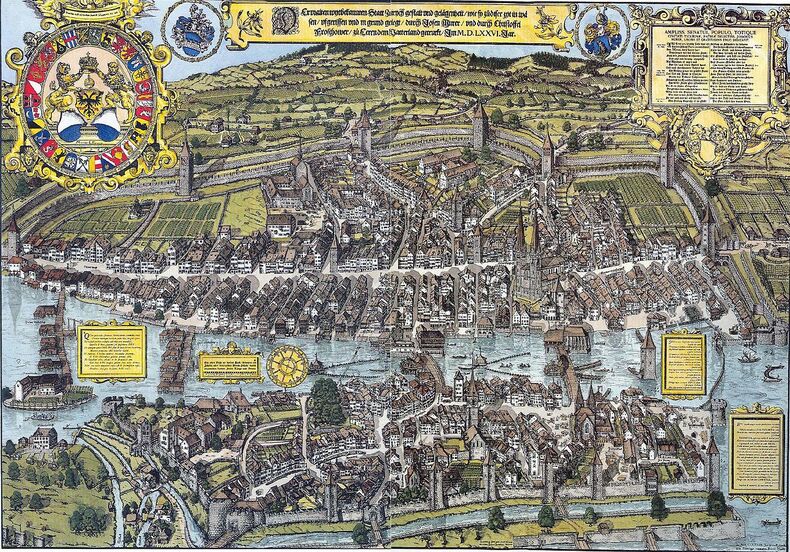
|
|
|
Murer, Jos;
Karte des Kantons Zürich 1566.
Zürich. Matthieu. 1967 58 x 48 cm. 6 Holzschnitte und 10 Bordürenteile. In Originalmappe.
书商的参考编号 : 2427DB
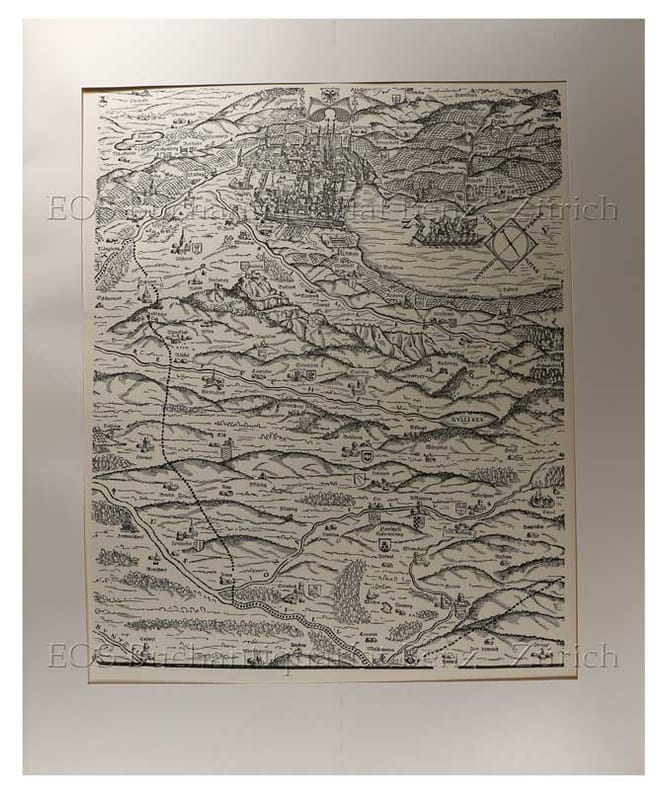
|
|
|
Muralt, Leonhard von:
Stammtafeln der Familie von Muralt in Zürich von ihrer Einwanderung im Jahre 1555 bis zum Jahre 1976.
Zürich, Berichthaus, 1976. Nicht paginiert. Mit 11 Falttafelnn (Stammbäumen). Beschrifteter Leinenband.
书商的参考编号 : 4909DB
|
|
|
Muralt, Leonhard von
Stammtafeln der Familie von Muralt in Zürich von ihrer Einwanderung im Jahre 1555 bis zum Jahre 1976.
Zürich, Berichthaus, 1976. Nicht paginiert. Mit 11 Falttafelnn (Stammbäumen). Beschrifteter Leinenband. + Wichtig: Für unsere Kunden in der EU erfolgt der Versand alle 14 Tage verzollt ab Deutschland / Postbank-Konto in Deutschland vorhanden +, 4909DB
书商的参考编号 : 4909DB

|
|
|
Murat Halstead War Correspondent Illust with Half Tone Engravings from Photographs Etchings & Military Maps of Phillippines
Story of the Philippines & Our New Possessions natural Riches Industrial Resources Statistics of Productions Commerce & Population The Eldorado of the Orient
Our Possessions Publ 1898. HB NODustJacket 1898 1st edition chips to btms of few pgs small mended tearPictorial embossed illustrated Cover with red & blue Gold gilt Lettering is Nice 512 pgs VG NODJ back Cover slight wrinkle & couple stains Cover light rub wear & tiny chips Extremities Interior nice tight clean light FoX Wear. First Edition. Hard Cover. Our Possessions Publ hardcover
书商的参考编号 : 2666
|
|
|
Murat Halstead war Correspondent engravings from Original Photographs Frontispiece with Tissue Guard
Story of the Philippines & Our New Possessions Including The Ladrones Hawaii Cuba & Porto Rico the Eldorado of the Orient
Our Possessions Publishing Co 1898. HB NO DJ Issued 1898 1st edition Interior Hinge Starting Pictorial Grey Red & Blue decorated Cover with Gold Gilt Slight Rub & Wear Few pages Small spots & Dogeared VG-/VG AS-IS NODJ. First Edition. Hard Cover. Our Possessions Publishing Co hardcover
书商的参考编号 : 8026
|
|
|
Murdoch Iris SIGNED via autographed slip & Michael McCurdy Wood engravings
Something Special: A Story
W. W. Norton & Co. 2000 An autographed slip of paper by Iris Murdoch has been mounted on the title page. This story was published after her death in this charming edition illustrated by McCurdy's wood engravings. A handsome two colour binding a protected unclipped jacket. Language: eng. Signed by Authors. 1st Edition. Hardcover. Fine/Fine. W. W. Norton & Co. hardcover
书商的参考编号 : ABE-1485691619800 ???????? : 0393050076 9780393050073

|
|
|
Murer, Jos
Karte des Kantons Zürich 1566.
Zürich., Matthieu., 1967. 58 x 48 cm. 6 Holzschnitte und 10 Bordürenteile. In Originalmappe. + Wichtig: Für unsere Kunden in der EU erfolgt der Versand alle 14 Tage verzollt ab Deutschland / Postbank-Konto in Deutschland vorhanden +, bild
书商的参考编号 : 2427DB

|
|
|
Murer, Josef
Der uralten wytbekannten Statt Zürich gestalt und gelägenheit, wie sy zu diser zyt in wäsen, ufgerissen und in grund gelegt, durch Josefen Murer und durch Christoffel Froschower, zu Eeren dem Vatterland getruckt, Im M.D.LXXVI Jar
Gattikon, Verlag Dorfpresse., 1966. Zehnfarben Lithografie auf festem Papier. Blattgrösse: 97 x 139 cm. + Wichtig: Für unsere Kunden in der EU erfolgt der Versand alle 14 Tage verzollt ab Deutschland / Postbank-Konto in Deutschland vorhanden +, Abbildung
书商的参考编号 : 1123DG

|
|
|
Murer, Josef
Der uralten wytbekannten Statt Zürich gestalt und gelägenheit, wie sy zu diser zyt in wäsen, ufgerissen und in grund gelegt, durch Josefen Murer und durch Christoffel Froschower, zu Eeren dem Vatterland getruckt, Im M.D.LXXVI Jar
Gattikon, Verlag Dorfpresse., 1966. Lithografie auf festem Papier. Blattgrösse: 97 x 139 cm. + Wichtig: Für unsere Kunden in der EU erfolgt der Versand alle 14 Tage verzollt ab Deutschland / Postbank-Konto in Deutschland vorhanden +, A|B [2 Warenabbildungen]
书商的参考编号 : 1733AG

|
|
|
Murer, Josef
Der uralten wytbekannten Statt Zürich gestalt und gelägenheit, wie sy zu diser zyt in wäsen, ufgerissen und in grund gelegt, durch Josefen Murer und durch Christoffel Froschower, zu Eeren dem Vatterland getruckt, Im M.D.LXXVI Jar
Gattikon, Verlag Dorfpresse., 1966. Zehnfarben Lithografie auf festem Papier. Blattgrösse: 97 x 139 cm. + Wichtig: Für unsere Kunden in der EU erfolgt der Versand alle 14 Tage verzollt ab Deutschland / Postbank-Konto in Deutschland vorhanden +, A
书商的参考编号 : 744DG

|
|
|
Murner, Thomas (Hrsg.)
Die disputacion vor den xij orten einer loblichen eidtgnoschafft nämlich Bern Luzern Ury Schwyz Undervalden ob unnd nidt dem kernwalt Zug mitt dem sampt usseren ampt Glaris Basel Friburg Solathorn Schaffhusen und Appenzell, von wegen der einigkeit in christlichem glauben in iren landen und undterthonen der fier bistumb Constentz Basel, Losanen und Chur beschehen und in dem iar Christi unsers erlösers Mccccc und xxvi uff den xvi tag des Meyens erhöret und zu Baden im ergöw irer stattgehalten unnd vollendet.
Luzern, Thomas Murner, 1527. Kl.-4°. (13) Bl. (v. 14), (168) Bl. (a-c4, d1 (d2 fehlt), A-Z4, Aa-Ss4). Lederband des 20. Jh. mit rotem verg. Rückenschild. + Wichtig: Für unsere Kunden in der EU erfolgt der Versand alle 14 Tage verzollt ab Deutschland / Postbank-Konto in Deutschland vorhanden +, bild
书商的参考编号 : 661DB

|
|
|
Murray, Joan ; Liss David;
Chaki
Large format book of Yehouda Chaki's works containing 111 pages of full color prints, usually one print per page. With chronology, exhibitions and collections and select bibliography at back. Book is in excellent condition. Binding is solid and square, covers have sharp corners and are creaseless, as is spine, exterior shows light shelf wear only, text/interior is clean and free of marking of any kind.

|
|
|
MUSAEUS: LUCAS FL. translator & BUCKLAND WRIGHT John engravings F. L.
HERO AND LEANDER. Translated from the Greek
Christopher Sandford 1949. 8vo 48pp black and white illustrations with tissue guards top edge gilt rough cut edges. A good hardback copy in mottled two tone cloth. Pages edges foxed bookplate on front paste-down. Limited edition # 382 of 500 copies. Christopher Sandford, 1949 hardcover
书商的参考编号 : 108635
|
|
|
Musee Des Beaux Arts De Vente et Cabinet Cantonal Des Estampes
Felix Bracquemond 1833 - 1914 : Graveur et Ceramiste
Vevey: Musee Jenisch / Somogy / Editions D'Art. As New. Paperback. FREE UPGRADE to Courier/Priority Shipping Upon Request - IN STOCK AND IMMEDIATELY AVAILABLE FOR SHIPMENT - AS NEW THE TEXT BLOCK IS PRISTINE CLEAN UNMARKED AND IN EXCELLENT CONDITION - -- with a bonus offer . Musee Jenisch / Somogy / Editions D'Art paperback
书商的参考编号 : 13183
|
|
|
Museum Bellerive Zurich Editor State Collection of Prints and Drawings Munich Editor
Hermann Obrist: Sculpture Space Abstraction around 1900
Verlag Scheidegger and Spiess 2009-05-15. Bilingual. Hardcover. Used:Good. Verlag Scheidegger and Spiess hardcover
书商的参考编号 : DADAX3858812390 ???????? : 3858812390 9783858812391
|
|
|
MUSIC, Zoran (Gorizia, 1909 - Venezia, 2005)
Senza titolo
Litografia originale a colori Firma a matita. Esemplare p.d.a.. cm 44,5x60. pp.. . Ottimo (Fine). . . .

|
|
|
MUSPER, H.TH
Der Holzschnitt in fünf Jahrhunderten.
Frankfurt/Main, Büchergilde Gutenberg, (1965). 4to. 400 S. m. 316 Textabb. u. 8 farbigen mont. Taf. OLwd m. OUmschl. (Umschl. m. geringen Lagerspuren).
书商的参考编号 : 1224050
|
|
|
Musset Alfred de
Fantasio: A Comedy in Two Acts; by Alfred De Musset; translated by Maurice Baring with slipcase
Paris: The Pleiad 1929. Hardcover. Fine. Giauque Fernand. 57 1 p. 1 hand-colored frontispiece 1 addition leaf of a hand-colored plate and 10 in-text illustrations; 28 cm. Original red cloth with gilt-rooled spine title. Burgundy slipcase with printed paper label on front section with handwritten copy number. Designed by Frederic Warde. This is no. 172 of a limited edition of 550. "The twelve illustrations ten in lithography and two hand-coloured have been made by Mr. Fernand Giauque. The Lutetia type used for the text designed by Mr. J. van Krimpen has been composed and printed by Joh. Ensched� en Zonen Haarlem Holland." -- Colophon. Former owner's name on front free endpaper Theodore W. Bozarth dated 1946. Inscribed by same hand at lower edge of back fixed endpaper: "S-- Trenton N.J." Theodore W. Bozarth 1918-2005 was a lieutenant colonel in the U.S. Air Force who served overseas in England and Japan. Book is in Fine Condition: clean and bright. Slipcase is in Very Good- Condition: edges are rubbed; minor separation at opening; otherwise solid; label is intact. <br/><br/> The Pleiad hardcover
书商的参考编号 : 004149

|
|
|
MUTHER, R
Geschichte der englischen Malerei.
Berlin, S. Fischer, 1903. Gr.-8vo. 400 S. m. 153 Abb. Illustrierter OLwdbd (Einbd etwas verblichen, leicht braunfleckig).
书商的参考编号 : 1227432
|
|
|